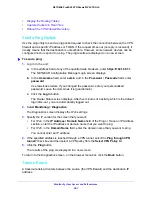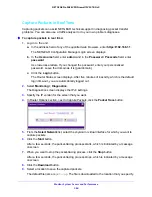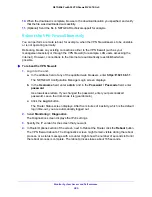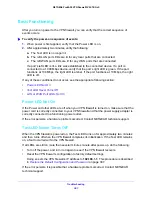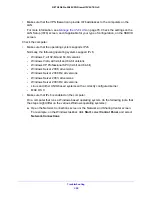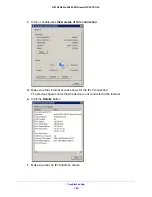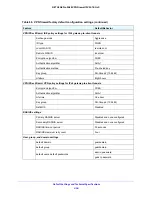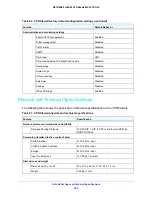
Troubleshooting
391
NETGEAR ProSAFE VPN Firewall FVS318G v2
•
For IPv4 connections, if your ISP requires a login, the login name and password might be
incorrectly set.
•
For IPv4 connections, your ISP might check for your computer’s host name.
On the Broadband ISP Settings screen for IPv4, in the
Account Name
field, enter the
host name, system name, or account name that was assigned to you by your ISP. You
might also need to enter the assigned domain name or workgroup name in the
Domain
Name
field, and you might need to enter additional information. For more information,
see
Manually Configure an IPv4 Internet Connection
on page 31.
•
Your ISP allows only one Ethernet MAC address to connect to the Internet and might
check for your computer’s MAC address.
In this case, do one of the following:
-
Inform your ISP that you are using a new network device, and ask them to use the
VPN firewall’s MAC address.
-
Configure your VPN firewall to spoof your computer’s MAC address. You can do this
in the Router’s MAC Address section on the Broadband Advanced Options screen.
For more information, see
Configure Advanced WAN Options and Other Tasks
on
page 52.
If your VPN firewall can obtain an IP address, but an attached computer is unable to load any
web pages from the Internet, it might be for one of the following reasons:
•
Your computer might not recognize any DNS server addresses.
A DNS server is a host on the Internet that translates Internet names (such as
www.netgear.com) to numeric IP addresses. Typically, your ISP provides the addresses
of one or two DNS servers for your use. You can configure your computer manually with
DNS addresses, as described in your operating system documentation
.
•
The VPN firewall might not be configured as the TCP/IP gateway on your computer.
Troubleshooting the IPv6 Connection
If you experience difficulty connecting over an IPv6 connection, the VPN firewall or the
computer from which you are trying to connect to the VPN firewall might not be configured
correctly:
Check the VPN firewall:
•
By default, the VPN firewall is set to IPv4-only mode.
Make sure that the VPN firewall is set to IPv4/IPv6 mode. For more information, see
Configure the IPv6 Routing Mode
on page 39.
•
Make sure that the ISP settings are correct.
For more information, see
Configure a Static IPv6 Internet Connection
on page 42. The
VPN firewall cannot receive a valid IPv6 address if the Internet connection is not correctly
configured.





